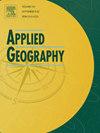了解城市重建过程中的临时居住流动性:结构化社区调查和机器学习分析的启示
IF 4
2区 地球科学
Q1 GEOGRAPHY
引用次数: 0
摘要
现有的城市更新研究主要关注城市重建的最终影响,而往往忽视了临时迁移阶段所产生的社会成本。由于许多居民在棚户区重建期间必须腾空房屋平均达 3-5 年之久,这给他们在返回重新安置的房屋之前带来了租房的挑战和相关的负面影响,因此这一差距非常明显。因此,本研究重点考察棚户区改造期间居民在等待安置期间产生的临时居住问题。我们选择了菏泽市作为案例研究区,该市在 2016 年至 2018 年期间经历了中国最密集的棚户区改造,约 120 万人口受到影响。我们进行了结构化社区调查,收集了 1035 个有效样本。然后,我们运用时空分析和随机森林模型研究了暂住人口流动的稳定性、方向、距离及其影响因素。研究结果显示,92.4%的家庭在暂住阶段只搬迁一到两次,这表明他们更倾向于稳定的居住地。在迁移方向上,住户寻求生活服务中心而非城市中心,更喜欢熟悉的社区环境。此外,74.8% 的家庭在原居住地 2.5 公里范围内重新安置,这表明他们更喜欢就近的临时住所。建筑环境是影响流动性的最关键因素,其次是家庭社会经济地位,而住房成本的影响却出人意料地最小。这项研究强调了在城市改造项目中考虑临时社会成本的重要性,并为住房市场监管和城市规划提供了有价值的见解,以减轻这些影响。本文章由计算机程序翻译,如有差异,请以英文原文为准。
Understanding temporary residential mobility during urban renewal: Insights from a structured community survey and machine learning analysis
Existing studies on urban renewal have primarily focused on the final effects of urban redevelopment, while often overlooked the social costs incurred during the temporary displacement phase. This gap is significant, as many residents must vacate their homes for an average of 3–5 years during Shantytown redevelopment, which brings about challenges of renting houses and the associated negative impacts on their well-being before returning to their resettled homes. Therefore, this study focuses on examining the temporary residence arising during Shantytown redevelopment while awaiting resettlement. We selected Heze city as our case study area, which has been through China's most intensive redevelopment between 2016 and 2018 that affected about 1.2 million population. A structured community survey was conducted, and 1035 valid samples were collected. We then applied spatiotemporal analysis and the Random Forest model to examine stability, direction, and distance of temporary residence mobility, along with its influencing factors. Findings reveal that 92.4% of households move just once or twice during the temporary phase, indicating the preference for stable residence. Regarding moving direction, households seek life service centers rather than city centers, and prefer familiar community environments. Furthermore, 74.8% of households resettled within 2.5 km of their original residence, indicating a preference for nearby temporary housing. The built environment emerged as the most critical factor influencing the mobility, followed by family socioeconomic status, while housing costs, surprisingly, having the minimal impact. This study highlights the importance of considering the interim social costs in urban renewal projects and provides valuable insights for housing market regulation and urban planning to mitigate these effects.
求助全文
通过发布文献求助,成功后即可免费获取论文全文。
去求助
来源期刊

Applied Geography
GEOGRAPHY-
CiteScore
8.00
自引率
2.00%
发文量
134
期刊介绍:
Applied Geography is a journal devoted to the publication of research which utilizes geographic approaches (human, physical, nature-society and GIScience) to resolve human problems that have a spatial dimension. These problems may be related to the assessment, management and allocation of the world physical and/or human resources. The underlying rationale of the journal is that only through a clear understanding of the relevant societal, physical, and coupled natural-humans systems can we resolve such problems. Papers are invited on any theme involving the application of geographical theory and methodology in the resolution of human problems.
 求助内容:
求助内容: 应助结果提醒方式:
应助结果提醒方式:


